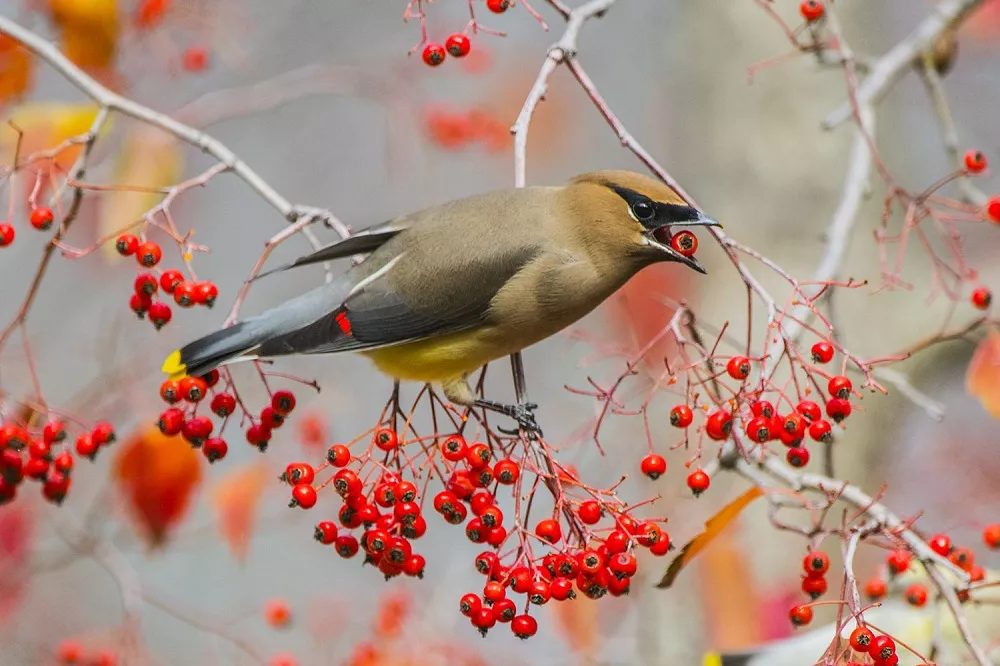Cedar Waxwings (Bombycilla cedrorum) are elegant and unique birds known for their sleek plumage and distinctive crested appearance. These migratory songbirds captivate observers with their graceful flight and melodious calls. In this article, we will delve into the habitat preferences and distribution of Cedar Waxwings, shedding light on the regions where these captivating birds call home.
Habitat Preferences:
Cedar Waxwings are adaptable birds that inhabit a variety of habitats across North America. They can be found in both rural and urban environments. Some of their preferred habitats include:
Forest Edges: Cedar Waxwings are commonly found in forest edges, where open spaces meet woodland areas. These transitional zones offer a rich food source and suitable nesting sites for the birds.
Woodlands and Forests: They are frequently spotted in deciduous forests, mixed woodlands, and riparian areas with a diverse tree canopy. These habitats provide an abundance of berries, insects, and other food sources that Cedar Waxwings rely on for sustenance.
Orchards and Gardens: Cedar Waxwings are known to visit orchards and gardens, particularly during the fruiting season. They are attracted to a variety of berries and fruits, such as cherries, mulberries, and juniper berries. Their presence in these areas can be beneficial for seed dispersal.
Wetlands and Riparian Areas: Cedar Waxwings are often found near wetlands, marshes, and riverside habitats. These areas offer a rich supply of insects, which are an important part of their diet, especially during the breeding season.
Distribution:
Cedar Waxwings have a broad distribution across North America, spanning from southern Canada to parts of Central America. Their range extends across the United States, including Alaska and Hawaii. Here are some key regions where Cedar Waxwings can be found:
North America: Cedar Waxwings breed throughout the northern United States and southern Canada, including provinces such as Ontario, Quebec, British Columbia, and Alberta. They can also be found in the southern United States, including states such as Florida, Texas, and Arizona.
Central America: During the non-breeding season, Cedar Waxwings migrate to parts of Central America, including Mexico, Belize, Guatemala, Honduras, and Costa Rica. They seek out warmer climates and abundant food sources during this time.
Behavior and Diet:
Cedar Waxwings are highly social birds that often gather in large flocks, particularly during the non-breeding season. They communicate through soft, high-pitched calls and are known for their synchronized flights and cooperative feeding behavior.
Their diet primarily consists of fruits, berries, and insects. They are particularly fond of fruits with high sugar content, such as cedar berries, dogwood berries, and wild cherries. Insects, including beetles, caterpillars, and ants, make up a significant portion of their diet, especially during the breeding season when they provide essential protein for their young.
Conservation and Threats:
Cedar Waxwings are not currently classified as globally threatened or endangered. However, they, like many other bird species, face threats such as habitat loss, pesticide use, and collisions with human-made structures like windows. Conserving and protecting their preferred habitats, promoting the use of bird-safe practices, and preserving natural areas are essential for their long-term survival.
Conclusion:
Cedar Waxwings are magnificent birds known for their crested appearance, melodious calls, and sociable behavior. Their adaptability allows them to thrive in various habitats, including forest edges, woodlands, orchards, and wetlands. By understanding their habitat preferences and distribution, we can appreciate the natural wonder of Cedar Waxwings and work towards their conservation. Let us continue to protect their habitats, promote responsible land management practices, and ensure their presence enriches our ecosystems for generations to come.
Related topics:
- What Does A Cedar Waxwing Look Like?
- Cedar Waxwing vs Bohemian Waxwing: What’s the Difference?
- What is a Bohemian Waxwing?


 Facebook
Facebook  Instagram
Instagram  Youtube
Youtube 